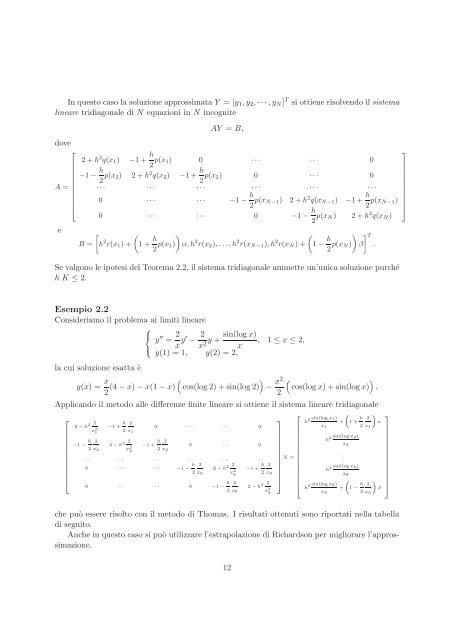problemi ai limiti per equazioni differenziali ordinarie - Sezione di ...
problemi ai limiti per equazioni differenziali ordinarie - Sezione di ...
problemi ai limiti per equazioni differenziali ordinarie - Sezione di ...
You also want an ePaper? Increase the reach of your titles
YUMPU automatically turns print PDFs into web optimized ePapers that Google loves.
In questo caso la soluzione approssimata Y = [y 1 ,y 2 , · · · ,y N ] T si ottiene risolvendo il sistemalineare tri<strong>di</strong>agonale <strong>di</strong> N <strong>equazioni</strong> in N incognitedove⎡A =⎢⎣eAY = B,2 + h 2 q(x 1 ) −1 + h 2 p(x 1) 0 · · · · · · 0−1 − h 2 p(x 2) 2 + h 2 q(x 2 ) −1 + h 2 p(x 2) 0 · · · 0B =· · · · · · · · · · · · · · · · · ·0 · · · · · · −1 − h 2 p(x N−1) 2 + h 2 q(x N−1 ) −1 + h 2 p(x N−1)0 · · · · · · 0 −1 − h 2 p(x N) 2 + h 2 q(x N )[ (h 2 r(x 1 ) + 1 + h )(2 p(x 1) α, h 2 r(x 2 ), . . .,h 2 r(x N−1 ), h 2 r(x N ) + 1 − h ) T2 p(x N) β].⎤⎥⎦Se valgono le ipotesi del Teorema 2.2, il sistema tri<strong>di</strong>agonale ammette un’unica soluzione purchéh K ≤ 2.Esempio 2.2Consideriamo il problema <strong>ai</strong> <strong>limiti</strong> lineare⎧⎨y ′′ = 2⎩ x y′ − 2 sin(log x)x2y + , 1 ≤ x ≤ 2,xy(1) = 1, y(2) = 2,la cui soluzione esatta èy(x) = x ( )2 (4 − x) − x(1 − x) cos(log 2) + sin(log 2) − x22()cos(log x) + sin(log x) .Applicando il metodo alle <strong>di</strong>fferenze finite lineare si ottiene il sistema lineare tri<strong>di</strong>agonale⎡ (⎡⎤2 − h 2 2x 2 −1 + h 2h 2 sin(log x 1)+ 1 + h0 · · · · · · 0x2 x1 1 1 2−1 − h 22 − h 2 22 x 2 x 2 −1 + h 2h 2 sin(log x 2)0 · · · 0x2 x2 2 2X =· · · · · · · · · · · · · · · · · ·0 · · · · · · −1 − h 22 − h 2 2⎢2 x 8 x 2 −1 + h .22 x8 8h⎥2 sin(log x 8)x 8⎣⎦ ⎢⎣(0 · · · · · · 0 −1 − h 222 − h 2 2x 9 x 2 9h 2 sin(log x 9)x 9+1 − h 2)2αx 1)2βx 9⎤⎥⎦che può essere risolto con il metodo <strong>di</strong> Thomas. I risultati ottenuti sono riportati nella tabella<strong>di</strong> seguito.Anche in questo caso si può utilizzare l’estrapolazione <strong>di</strong> Richardson <strong>per</strong> migliorare l’approssimazione.12
















